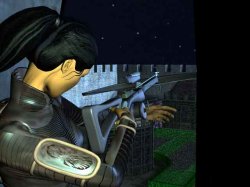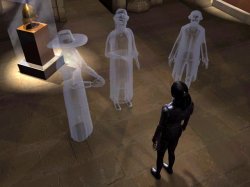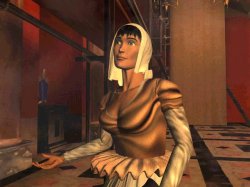|
The Messenger / Louvre: The Final Curse
 I usually try to mix my games up, not only in terms of plots and locations, but also with respect to styles - first person, third person, animated, full motion video etc. So having just finished Dracula: The Last Sanctuary, I was a little reluctant to embark upon this game next. Certainly the plot and locations are different, but the game comes out of a very similar stable, and it plays (same cursors, same movement, same mix of first person and cut scenes) and "looks" the same. Upon loading, I immediately wondered whether I needed something different.
I should not have worried. Despite some obvious familiarities, this game is good fun, and sufficiently different. Plus you get to wear black spandexJ.
You play Secret Agent Morgane Sinclair, who is tasked with breaking into the Louvre and finding Satan's Keys, 4 objects which, if brought together, have the power to create Armageddon. The Black Templars seek the Keys to gain revenge for the demise of their Order at the hands of Philippe the Good in the 14th century. You must find them first.
Your search takes place entirely inside the Louvre, but a time portal, hidden deep inside, means that you will have to look in four different time eras, and as the Louvre changed over the centuries, so your search will be different each time. The involvement of the Reunion des Musees Nationaux means the recreations are historically accurate, and some short historical notes, provided by your father and accessed via a recorder, provide some clues to aid your mission.
Fear not - the historical musings are short, entirely at your control, and largely unnecessary. They are in no way central to the game play, and in retrospect, I believe you could avoid them entirely. (Rosemary breathes a sigh of relief J). I usually try to mix my games up, not only in terms of plots and locations, but also with respect to styles - first person, third person, animated, full motion video etc. So having just finished Dracula: The Last Sanctuary, I was a little reluctant to embark upon this game next. Certainly the plot and locations are different, but the game comes out of a very similar stable, and it plays (same cursors, same movement, same mix of first person and cut scenes) and "looks" the same. Upon loading, I immediately wondered whether I needed something different.
I should not have worried. Despite some obvious familiarities, this game is good fun, and sufficiently different. Plus you get to wear black spandexJ.
You play Secret Agent Morgane Sinclair, who is tasked with breaking into the Louvre and finding Satan's Keys, 4 objects which, if brought together, have the power to create Armageddon. The Black Templars seek the Keys to gain revenge for the demise of their Order at the hands of Philippe the Good in the 14th century. You must find them first.
Your search takes place entirely inside the Louvre, but a time portal, hidden deep inside, means that you will have to look in four different time eras, and as the Louvre changed over the centuries, so your search will be different each time. The involvement of the Reunion des Musees Nationaux means the recreations are historically accurate, and some short historical notes, provided by your father and accessed via a recorder, provide some clues to aid your mission.
Fear not - the historical musings are short, entirely at your control, and largely unnecessary. They are in no way central to the game play, and in retrospect, I believe you could avoid them entirely. (Rosemary breathes a sigh of relief J).
The game book describes your mission thus: "Utilizing logic, stealth, hi-tech gadgets and weaponry, delve into dangerous worlds of intrigue, murder and mysticism". This is as good a summary as any. The game felt at times like Thief (creeping around avoiding detection) and at other times like Traitors Gate (finding and using sophisticated gadgets to access other parts of the Louvre). You get to drug footmen and shoot the odd guard, dress up in various disguises, decipher arcane texts to find secret passages, and make use of the best potions and spells alchemy has to offer. All around you is mystery and intrigue - Kings are murdered, Queens suspected and plots hatched. You will interact with a variety of characters, some giving you more help than others. Treachery is never far away. And if you are unlucky, you will be captured (presumably tortured - at various times you can hear some not so subtle interrogations) and you will have to start that era over again.
 I must admit that I was probably more impressed by this game after an hour's playing than I thought I would be, or than I have been with many other games I have played. There was an appealing blend of different things to do which gave it a different flavour to other similar inventory type games. That appeal was a bit less towards the end of the game - some of the sequences had become a bit "samey". The mixture of modern gadgets and age-old magic was nicely balanced, although I would have liked a bit more variety in some of the gadgets. And did I mention the spandex? I must admit that I was probably more impressed by this game after an hour's playing than I thought I would be, or than I have been with many other games I have played. There was an appealing blend of different things to do which gave it a different flavour to other similar inventory type games. That appeal was a bit less towards the end of the game - some of the sequences had become a bit "samey". The mixture of modern gadgets and age-old magic was nicely balanced, although I would have liked a bit more variety in some of the gadgets. And did I mention the spandex?
Comments on some of the gameboards had led me to fear the way the inventory worked in Messenger, but whilst it could have been a bit more efficient (a fewer mouse clicks) I thought it was on the whole a plus, not a minus. Put simply, you can't carry everything you find so you have to make decisions about what you will take with you at any one time. Many role playing games and even some action games limit what you can put in your backpack, and even how much weight you can carry based on your physical attributes, but the backpacks (or coat pockets) of an adventure are almost always bottomless pits capable of containing everything smaller than a refrigerator. Having to decide what to take and what to leave behind is far more real, and was for me a nice change.
In fact, you don't really leave anything behind in the truest sense. You take items out of your inventory by putting them in chests that you find in various places. At any time you can come back and rummage through the chest to get other stuff. Curiously though, once you put something in a chest, it shows up in every chest in every location, and as there are plenty of chests, nothing you need is far away. Also, once you have accessed a room or location, you can use a map to transport you straight back there, so you don't even have to walk back to the nearest chest. In essence, you have two inventories, one you take with you and one that requires a mouse click or two to get to.
I would have preferred it if I had had to keep track of which chest I had put things in, and for my decisions to leave behind important items to be a bit more punishing. Indeed, had it been less forgiving, it may have led to less criticism by those that don't like the current arrangement - inventory management might have been seen as strategic rather than annoying. As I said though, I quite enjoyed it.
My main complaint was that at times I found myself moving my cursor over every inch of a scene (and given the freedom of movement that is a lot of inches) in order to find a hotspot. I don't want to overstate this factor. Searching is part of the fun, and I do not want things to light up and shout, "look at me". Generally the unfolding plot or the solving of a puzzle would give a clue about where to look, but there was the occasional spot that seemed to be a question of luck. If you didn't look up (or down) at the right part of the scene and paint the right part of the roof (or floor), you were stuck.
 I was never stumped by a puzzle, but had to get hints at times about where the next hot spot was. A few didn't generate until you had triggered an event, so it pays to look somewhere more than once. On the whole, Morgane continued to move along at a good pace. Occasionally though, she ground to a halt, with nothing to indicate where she should look. I was never stumped by a puzzle, but had to get hints at times about where the next hot spot was. A few didn't generate until you had triggered an event, so it pays to look somewhere more than once. On the whole, Morgane continued to move along at a good pace. Occasionally though, she ground to a halt, with nothing to indicate where she should look.
As I said, this game looks like the Dracula games, which is high praise. Though not appearing on the game box or manual, Arxel Tribe are credited with the 3D scenes and animations, and they are of a high quality. If you have an historical bent, you can be impressed by the recreated and changing Louvre - if not, you can simply enjoy poking around a big, graphically sumptuous castle. The puzzles and conundrums are fairly gentle - predominantly they involve using the right item (or items) in the right spot, or finding and deciphering the right manuscript or clue. You can die or be captured, and there are a few timed dilemmas. Perhaps by way of compensation for those who don't like things timed, there are no mazes or sliders or music puzzles - plus they give you a spandex suit.
There is a suitable array of ambient sound, and at times you will need to listen to that sound for clues. There are no subtitles. Character dialogue is at times a bit rigid - the same character tells you the same thing, long after you have done what it is you are told about.
The Messenger is not a long game (and the inventory management certainly adds to the time taken) but nor did I feel cheated. It comes on two CDs, and disc swapping is limited. You do need to start each time by inserting CD 1, but if you have two CD drives, just put a CD in each and the game will sort things out for itself.
If you are captured, the game starts again at the time era you are currently playing. As such, the 8 save game slots are plenty. You save by pasting the current scene in one of the slots. You also start each era without any inventory items, at least until you find your first chest and re-equip yourself with some old trusted favourites.
All up, despite some minor complaints, I enjoyed this game - and would probably have done so even without the spandex.
Copyright © Steve Ramsey 2001.
All rights reserved.
System Requirements:
Windows 95/98/ME
Pentium 166 MHz (200 MHz recommended),16 MB RAM (32 MB recommended)
4x CD ROM (8x recommended), 3D Accelerator video card,16 bit sound card
Macintosh
PowerPC G3 or iMac / OS 8, 32 MB RAM (64 MB recommended), 4x CD ROM (8x recommended), 3D Accelerator video card, 16 bit sound card.
|
